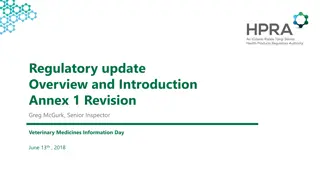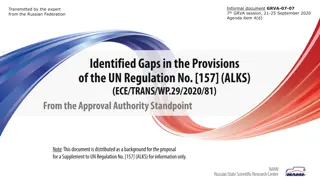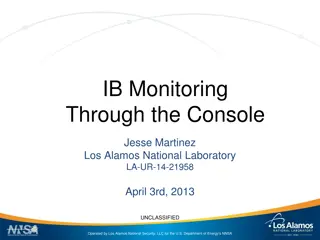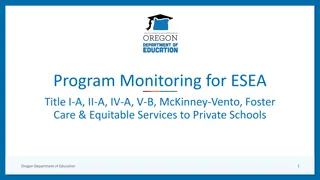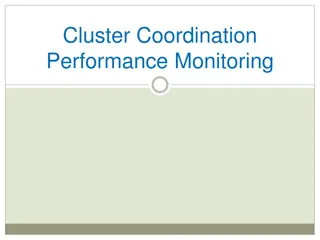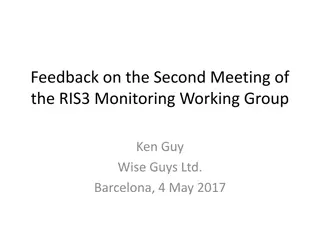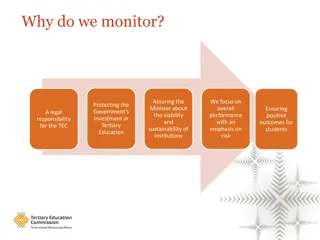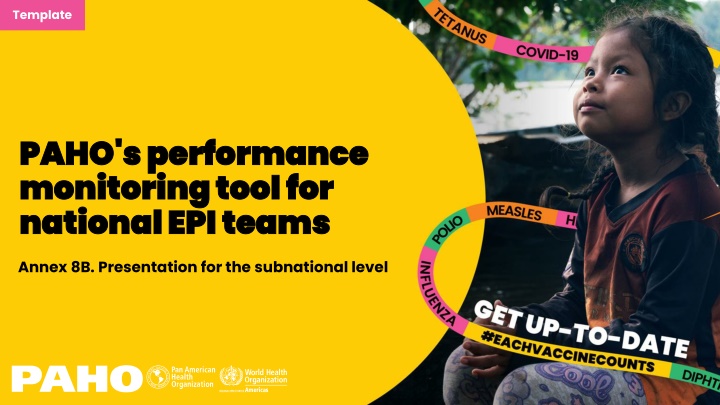
Comprehensive Performance Monitoring Tool for National EPI Teams
Self-assess and enhance the performance of national immunization programs with a comprehensive monitoring tool. Assess across 13 EPI components, set priorities, and improve program effectiveness at national and sub-national levels.
Download Presentation

Please find below an Image/Link to download the presentation.
The content on the website is provided AS IS for your information and personal use only. It may not be sold, licensed, or shared on other websites without obtaining consent from the author. If you encounter any issues during the download, it is possible that the publisher has removed the file from their server.
You are allowed to download the files provided on this website for personal or commercial use, subject to the condition that they are used lawfully. All files are the property of their respective owners.
The content on the website is provided AS IS for your information and personal use only. It may not be sold, licensed, or shared on other websites without obtaining consent from the author.
E N D
Presentation Transcript
Template PAHO's performance PAHO's performance monitoring tool for monitoring tool for national EPI teams national EPI teams Annex 8B. Presentation for the subnational level
Agenda Agenda Aim and objective of the tool Different parts of the tool Rating questions on a maturity scale Key points to consider Guide to conducting the assessment
The tools objective is to The tool s objective is to Self-assess performance of the national immunization program in the country across 13 EPI components using a comprehensive performance management tool to identify successes and gaps and set priorities for the program
And it aims to And it aims to To self-assess the performance of each component of EPI (as shown in the diagram) Develop a national action plan for the improvement of EPI and to: Prioritize the recommendations that require immediate intervention Define the timeline for activities and budget required. Determine if further assessment or support is required to address gaps in a specific component.
Purpose of the tool at the sub Purpose of the tool at the sub- -national and local level local level national and This tool aims to self assess the performance of national EPI and identify achievements and gaps in the program and promote improvement At the sub-national and local level, the tool serves as means to validate the claims made at the national level It allows to review local implementation, helping to confirm and supplement the national-level findings The scores generated at the sub-national and local level do not contribute to the final assessment score. They play a crucial role in informing and refining the national-level score by providing a more granular understanding of the program's performance
The tool has different four main parts to The tool has different four main parts to it it 1. Questions 3. National/sub national level 2. Five-point maturity scale 4. Sub sections
And a total of And a total of 196 questions across all components: 109 at the national level 67 at the subnational level 20 at the local level
The five-point scale helps to assess maturity across each question LEVEL 3: DEFINED The available elements are implemented with the functionality of a routine system. Biases or problems are not recognized. LEVEL 5: OPTIMIZED LEVEL 1: INITIAL All elements are available, reliable, complete, up-to-date and implemented in a standardized and efficient way. Insufficient or unavailable elements. 1 2 3 4 5 LEVEL 2: MANAGED The available elements present problems of completeness, updating, their use is not appropriate. LEVEL 4: QUANTITATIVELY MANAGED All items are available, reliable, complete, up-to-date. And some biases/problems are known that can be improved.
There are four key points to consider when conducting the self-assessment The tool is self-administered by the country PAHO CIM advisors only provide support and technical clarifications. They do not provide recommendations to select a final rating The tool is designed for self-assessment EPI and promoting improvement in the program. It is not intended to evaluate or pass judgment on the country's performance. The maturity scale rating is not the primary focus; identifying the underlying causes of bottlenecks and achievements is what will aid the country's improvement.
The tool will be implemented in three phases. Phase two is related to the sub-national level Phase 2a: Implementation at sub-national and local level 6. Review components 2-13 with the sub- national level participants on the excel version of the tool. 1. Select three sub-national areas where the self-assessment can be conducted 1. Select three health facilities in each sub- national area for the field visit 6. Score each question and write brief notes detailing the reasons behind the scoring 1. Coordinate with the EPI officers of the three sub-national areas to gauge willingness to receive the field visits 6. Conduct field visit to self-assess component 14 6. Compile the scores for each question at the sub-national and local level into a single excel version of the tool. These findings will be used to inform the national-level self-assessment 1. Finalize dates of the field visits 1. Identify 1-2 persons from the national level to travel to the sub-national level to support the implementation of the assessment Note: It is at the sub-national level's discretion to determine how many sub-national levels and health facilities can be visited






